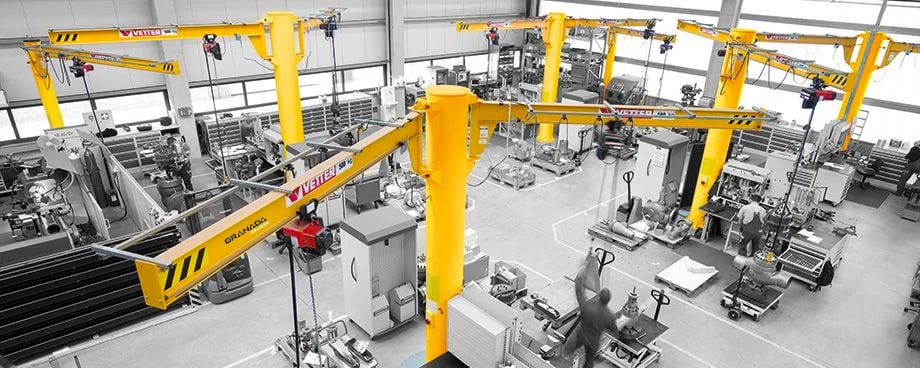Efficiency, precision, and safety are paramount in the aerospace industry. From the manufacturing of aircraft components to the assembly of entire aircraft, cranes play a crucial role in ensuring that operations run smoothly and effectively. At Granada Cranes, we have a proud history of working with industry leaders such as Airbus and BAE Systems, providing them with the advanced crane solutions they need to maintain their high standards. Here’s how different types of cranes can be utilised in the aerospace sector with practical examples.
Overhead Cranes

Overhead Cranes are essential in the aerospace industry, providing robust lifting capabilities for large components and assemblies. These cranes are ideal for tasks that require moving heavy parts, such as wings and fuselage sections, across extensive manufacturing areas.
- Single Girder Cranes: Used for lighter tasks, such as lifting smaller parts like landing gear components or aircraft seats. They offer a cost-effective solution for handling these smaller but essential components.
- Double Girder Cranes: Provide the necessary strength for lifting heavier items, such as aircraft engines or entire fuselage sections. For instance, during the assembly of an aircraft, double girder cranes can lift and precisely position the fuselage, ensuring accuracy and safety.
- Overhead Travelling Cranes: Allow for the movement of parts across multiple bays, enhancing workflow efficiency. These cranes are often used to transport large wing assemblies from one part of the facility to another, facilitating a seamless production process.
Gantry Cranes

Gantry Cranes offer versatility and mobility, making them suitable for both indoor and outdoor aerospace applications. They are particularly useful for handling large components that need to be moved across different areas without the constraints of a fixed installation.
- These cranes facilitate the efficient loading and unloading of parts, such as moving large pallets of raw materials into the manufacturing area.
- They are also used to transfer large assemblies like fuselage sections or wing structures between different stages of the assembly process, ensuring smooth workflow and reducing downtime.
Swing Jib Cranes

Swing Jib Cranes provide precision and manoeuvrability, which are crucial for tasks that require fine control and accurate positioning of components.
- The rotating jib arm allows for the easy handling of smaller parts, making these cranes ideal for assembly lines and maintenance areas. For example, they can be used to install cockpit instruments or avionics, requiring precise placement and secure handling.
- In maintenance areas, swing jib cranes can assist in lifting and positioning parts that need repair or replacement, such as removing and reinstalling ailerons or flaps.
Hoists & Monorails

Hoists and Monorails are indispensable for the streamlined movement of components within aerospace facilities. They enable the horizontal transport of parts along fixed paths, reducing manual handling and speeding up production processes.
- Hoists lift and lower heavy items, such as aircraft wheels and tyres during maintenance checks, ensuring they can be quickly and safely moved to the required location.
- Monorails provide a track system for horizontal movement, perfect for moving components along the production line. For example, they can transport seating units from the assembly area to the installation zone efficiently and safely.
Vacuum Lifting

Vacuum Lifting Systems are designed for the safe and damage-free handling of delicate and irregularly shaped aerospace components. Using suction technology, these systems provide a secure grip on parts, minimising the risk of damage during lifting and transport.
- Vacuum lifting is ideal for handling sensitive materials such as composite panels and glass components. For instance, when installing windshields or canopy glass in aircraft, vacuum lifters ensure these fragile components are securely handled without risk of breakage.
- These systems can also be used to move lightweight but awkwardly shaped components, like interior panels or insulation materials, ensuring precise placement and minimal risk of damage.
Automated Crane Systems
Integrating these various crane solutions into an automated system can revolutionise aerospace manufacturing and assembly processes.
- Automation enables precise, consistent operation, reducing the likelihood of human error and enhancing safety. For example, automated cranes can be programmed to follow exact paths when assembling aircraft sections, ensuring consistent quality and precision.
- Automated systems can be programmed for repetitive tasks, such as component assembly and material handling, improving speed and accuracy. This is particularly useful for tasks like riveting panels or installing seats, where consistent repetition is key.
- Integration with manufacturing execution systems (MES) allows for real-time tracking and coordination, optimising workflow and inventory management. This ensures that all parts are where they need to be at the right time, streamlining the entire production process.
- Remote monitoring and control offer the flexibility to manage crane operations from a centralised location, responding swiftly to changing production needs. This allows for quick adjustments and troubleshooting, keeping the assembly line running smoothly.
In the aerospace industry, where precision and reliability are critical, advanced crane solutions from Granada Cranes provide the necessary support to ensure efficient and safe operations. Our experience with Airbus and BAE Systems highlights our capability to deliver high-quality, customised crane solutions. By integrating these cranes into automated systems, aerospace manufacturers can achieve unparalleled control and efficiency in their operations. Contact us today to find out how our crane solutions can elevate your aerospace projects to new heights.




